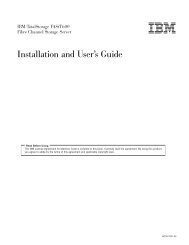Addressing OLTP Solutions with CICS: The Transaction Server ... - Ibm
Addressing OLTP Solutions with CICS: The Transaction Server ... - Ibm
Addressing OLTP Solutions with CICS: The Transaction Server ... - Ibm
You also want an ePaper? Increase the reach of your titles
YUMPU automatically turns print PDFs into web optimized ePapers that Google loves.
2.1 IBM Software <strong>Server</strong>s<br />
2.1.1 Lotus Notes<br />
In this section we provide an overview of all of the IBM Software <strong>Server</strong>s except<br />
the IBM <strong>Transaction</strong> <strong>Server</strong>, which we covered in detail in 2.2, “IBM <strong>Transaction</strong><br />
<strong>Server</strong>” on page 17.<br />
Lotus Notes Release 4 allows you to find, manage, and share all information you<br />
need. Notes has a new, intuitive user interface that is based on the<br />
market-leading product cc:Mail. Whether it is on the Internet, in relational<br />
databases or host systems, in a desktop application, or in E-mail, Lotus Notes<br />
provides an easy-to-use central access point for data sharing.<br />
With the Notes new Release 4 InterNotes Web Navigator, you can leverage (not<br />
just surf) the Web, capturing and managing relevant business information and<br />
putting it to immediate use every day.<br />
Everyone can communicate and collaborate, as individuals or teams, whether<br />
they are using Windows, OS/2, Mac, UNIX, or NT. In the office or on the road,<br />
ideas and information are continually exchanged and updated, giving you the<br />
competitive edge.<br />
With scalable servers supporting up to 1000 users and powerful administration<br />
capabilities, managing a Notes system is easy. Thus you can implement custom<br />
applications to leverage your greatest asset of all: the combined experience and<br />
knowledge of your people.<br />
2.1.2 IBM Communications <strong>Server</strong><br />
Systems Network Architecure (SNA) remains a key networking protocol in<br />
enterprise environments that include MVS and VM mainframes as well as AS/400<br />
systems. <strong>The</strong> Communications <strong>Server</strong> provides SNA and Advanced Peer-to-Peer<br />
Networking (APPN) communication for the other IBM Software <strong>Server</strong>s and<br />
clients they support. It also provides transport independence, allowing LU<br />
6.2-based and Sockets-based applications to run over either SNA or TCP/IP<br />
networks.<br />
2.1.3 IBM Directory and Security <strong>Server</strong><br />
2.1.4 IBM Database <strong>Server</strong><br />
16 <strong>CICS</strong> for AIX as the <strong>Transaction</strong> <strong>Server</strong><br />
<strong>The</strong> distributed directory and security functions of the Directory and Security<br />
<strong>Server</strong> are essential to providing transparent access to distributed resources.<br />
<strong>The</strong> Directory and Security <strong>Server</strong> is based on open technology, namely, the<br />
Distributed Computing Environment (DCE) for the Open Software Foundation<br />
(OSF), which offers open services for information access in large, heterogeneous<br />
networks. <strong>The</strong> Directory and Security <strong>Server</strong> is available for the IBM OS/2 Warp<br />
and IBM AIX platforms.<br />
<strong>The</strong> Database <strong>Server</strong> provides management of and access to data stored locally<br />
or in remote systems. Access to data through the World Wide Web (WWW) is<br />
provided. This full-functioned structured query language (SQL) relational<br />
database system is designed to manage data for the individual, the workgroup,<br />
and companywide solutions needed in today′s business world.
















